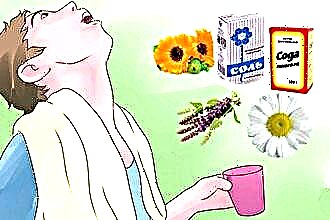The nervous system and the vegetative section, the sympathetic and parasympathetic parts regulate the work of all internal organs, muscles, tissues autonomously, without our consciousness and thinking. Factors such as alcoholism and smoking significantly disrupt the functioning of the nervous system, and thereby negatively affect the work of the heart and blood vessels, lungs, digestive tract, and urination. Stress and neuroses also have a damaging effect, which together leads to psychosomatic disorders that require medical attention and treatment.
The mechanism of the influence of alcohol on the autonomic system of the patient
Alcohol has an extremely negative effect on the entire body as a whole. Absorbed in the digestive tract, ethanol from the alcoholic drink quickly enters the cerebral hemispheres with the bloodstream, damaging the cells of the central nervous system. Further, with the blood flow, the toxic metabolite of alcohol enters the peripheral and vegetative sections. The main detrimental effect of ethanol on the body is associated with the damaging effect on the neurons of the brain, the mechanism for the production of neurotransmitters that ensure the transmission of nerve impulses. This disrupts the coordination of the autonomic nervous system, the work of internal organs, affects the heart and blood vessels, respiration, digestion, metabolism and thermoregulation. In this connection, we can conclude that vd and alcohol are incompatible.
In patients with VSD, alcohol consumption aggravates the course of the underlying disease, a neurocirculatory disorder, and leads to the development of the following syndromes:
- Cardiac - worried about pain in the heart, chest discomfort, general weakness and fatigue.
- Tachycardic - after drinking strong drinks, the heartbeat increases significantly, there is a trembling in the chest, a feeling of heat. It is often complicated by hypertensive syndrome, with episodes of a sharp increase in pressure by 20-30 mm Hg.
- Bradycardic - after consuming a large amount of alcohol, the pressure drops sharply, with a hangover syndrome, weakness, dizziness, nausea, flashing of flies before the eyes are felt, coordination is impaired.
- Arrhythmic - after drinking alcohol, the pressure rises sharply and the pulse and heart rate become more frequent. Breathing becomes difficult, there is a feeling of a lump in the throat, lack of oxygen, nausea or vomiting.
- Psychoneurotic - alcohol intake provokes anxiety, fear, sudden mood swings, panic attacks and attacks of respiratory distress against a background of stress.
Is it allowed to drink alcohol for patients with VSD?
In the presence of vegetative dystonia, alcohol should be consumed only in small quantities. Alcohol abuse in case of dysfunction of the nervous system leads to extremely negative consequences. A hangover with VSD is much more severe, strong drinks can provoke:
- an attack of tachycardia or arrhythmia;
- hypertension, hypertensive crisis;
- stroke;
- heart attack;
- an attack of inexplicable fear, panic;
- outbursts of aggression;
- depression, negative thoughts.
It is most dangerous to drink alcohol with hypertensive type and mixed type, when there is a high risk of cerebrovascular accident, stroke, heart attack. At the age of 30-45, alcohol contributes to the development of coronary pathology, chronic heart failure, which leads to disability and a deterioration in the quality of life.
Smoking and dystonia compatibility: is it allowed to smoke?
When smoking, a sufficient amount of nicotine, tar and other substances enters the human body with smoke, which disrupt and block the work of nerve receptors. Carbon dioxide is also destructive, causing spasms of small vessels, which impedes the blood flow of oxygenated blood, and leads to hypoxia of the brain, heart and the body as a whole.
With VSD, the additional negative effect of nicotine and tar aggravates the general condition. It can lead to an attack of tachyarrhythmias, stroke, heart attack. It manifests itself with the following symptoms in smokers:
- Difficulty breathing, with the usual physical activity, shortness of breath, chest pain are worried.
- There is a feeling of shortness of breath.
- Cases of cardiac pain and palpitations are increasing.
- The general psychological state worsens, sleep is disturbed, and efficiency decreases.
- Anxiety disorder, attacks of fear occur more often.
Marijuana, hashish, hookah and other substances, when ingested, have a significant effect on the nervous system, the brain and the process of transmitting information. Having a somewhat similar structure in chemical structure with natural neurotransmitters, drugs disrupt the action of nerve impulses, which leads to severe dysfunction of the autonomic department, and aggravates the course of VSD. What manifests itself in a smoker:
- bouts of euphoria and depression, panic attacks, hallucinations with periods of exacerbation;
- frequent mood swings, poor sleep, insomnia, impaired memory, thinking, coordination and reaction;
- headache, a sharp deterioration in the condition after using drugs;
- increased intracranial pressure;
- attacks of cardialgia, arrhythmias;
- violation of thermoregulation, chills, fever, increased sweating;
- indigestion, intestinal upset, diarrhea, heartburn, recurrent stomach pain
Conclusions
The main cause of VSD is psychological problems, concomitant endocrine and coronary diseases, chronic emotional and physical overload. Dystonia is not a disease, but defines a complex of symptoms that, if untreated, can lead to dangerous consequences. Smoking and drinking alcohol significantly worsens the course of neurocirculatory dystonia, thereby aggravating the state of the autonomic nervous system. Therapy, which consists in maintaining a correct lifestyle, quitting smoking cigarettes and taking drugs, reducing the dose of alcohol. This is the only way to cure vegetative-vascular dystonia, alleviate the patient's condition and prevent the development of cardiac and psycho-emotional pathology.



